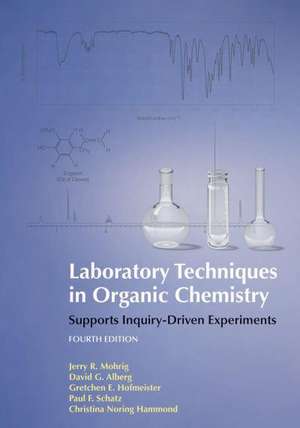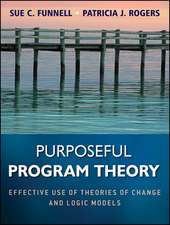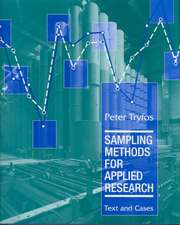Mohrig, J: Laboratory Techniques in Organic Chemistry
Autor Jerry R. Mohrig, David Alberg, Gretchen Holifmeister, Paul F. Schatz, Christina Noring Hammonden Limba Engleză Paperback – 12 mai 2014
Laboratory Techniques in Organic Chemistry is the most comprehensive and detailed presentation of the lab techniques organic chemistry students need to know. Compatible with any organic chemistry lab manual or set of experiments, it combines specific instructions for three different kinds of laboratory glassware: miniscale, standard taper microscale, and Williamson microscale. It is written to provide effective support for guided-inquiry and design-based experiments and projects, as well as for traditional lab experiments.
Preț: 504.22 lei
Preț vechi: 771.13 lei
-35% Nou
Puncte Express: 756
Preț estimativ în valută:
96.48€ • 101.01$ • 79.83£
96.48€ • 101.01$ • 79.83£
Carte disponibilă
Livrare economică 15-29 martie
Livrare express 01-07 martie pentru 104.54 lei
Preluare comenzi: 021 569.72.76
Specificații
ISBN-13: 9781464134227
ISBN-10: 1464134227
Pagini: 528
Ilustrații: illustrations
Dimensiuni: 254 x 181 x 17 mm
Greutate: 0.75 kg
Ediția:Revizuită
Editura: W. H. Freeman and Company
Locul publicării:New York, United States
ISBN-10: 1464134227
Pagini: 528
Ilustrații: illustrations
Dimensiuni: 254 x 181 x 17 mm
Greutate: 0.75 kg
Ediția:Revizuită
Editura: W. H. Freeman and Company
Locul publicării:New York, United States
Cuprins
PART I: INTRODUCTION TO THE ORGANIC LABORATORY Essay: Introduction to the Organic Laboratory
1. Safety in the Laboratory
2. Protecting the Environment
3. Laboratory Notebooks and Prelaboratory Information
PART II: CARRYING OUT CHEMICAL REACTIONS Essay: Carrying Out Chemical Reactions
4. Laboratory Glassware
5. Measurements and Transferring Reagents
6. Heating and Cooling Methods
7. Carrying out Organic Reactions
8. Computational Chemistry
PART III: BASIC METHODS FOR SEPARATION, PURIFICATION, AND ANALYSIS Essay: Intermolecular Forces in Organic Chemistry
9. Filtration
10. Extraction
11. Drying Organic Liquids and Recovering Reaction Products
12. Boiling Points and Distillation
13. Refractometry
14. Melting Points and Melting Ranges
15. Recrystallization
16. Sublimation
17. Optical Activity and Enantiomeric Analysis
PART IV: CHROMATOGRAPHY Essay: Modern Chromatographic Separations
18. Thin-Layer Chromatography
19. Liquid Chromatography
20. Gas Chromatography PART V: SPECTROMETRIC CHARACTERIZATION METHODS Essay: The Spectrometric Revolution
21. Infrared Spectroscopy
22. Nuclear Magnetic Resonance Spectroscopy
23. 13C and Two-Dimensional NMR Spectroscopy
24. Mass Spectrometry
25. Ultraviolet and Visible Spectroscopy
26 . Integrated Spectrometry Problems
PART VI: DESIGNING AND CARRYING OUT ORGANIC EXPERIMENTS
27. Using the Literature of Organic Chemistry
28. Designing a Chemical Reaction
1. Safety in the Laboratory
2. Protecting the Environment
3. Laboratory Notebooks and Prelaboratory Information
PART II: CARRYING OUT CHEMICAL REACTIONS Essay: Carrying Out Chemical Reactions
4. Laboratory Glassware
5. Measurements and Transferring Reagents
6. Heating and Cooling Methods
7. Carrying out Organic Reactions
8. Computational Chemistry
PART III: BASIC METHODS FOR SEPARATION, PURIFICATION, AND ANALYSIS Essay: Intermolecular Forces in Organic Chemistry
9. Filtration
10. Extraction
11. Drying Organic Liquids and Recovering Reaction Products
12. Boiling Points and Distillation
13. Refractometry
14. Melting Points and Melting Ranges
15. Recrystallization
16. Sublimation
17. Optical Activity and Enantiomeric Analysis
PART IV: CHROMATOGRAPHY Essay: Modern Chromatographic Separations
18. Thin-Layer Chromatography
19. Liquid Chromatography
20. Gas Chromatography PART V: SPECTROMETRIC CHARACTERIZATION METHODS Essay: The Spectrometric Revolution
21. Infrared Spectroscopy
22. Nuclear Magnetic Resonance Spectroscopy
23. 13C and Two-Dimensional NMR Spectroscopy
24. Mass Spectrometry
25. Ultraviolet and Visible Spectroscopy
26 . Integrated Spectrometry Problems
PART VI: DESIGNING AND CARRYING OUT ORGANIC EXPERIMENTS
27. Using the Literature of Organic Chemistry
28. Designing a Chemical Reaction
Notă biografică
Jerry Mohrig, Carleton College, USA.
David Alberg, Carleton College, USA.
Gretchen Holifmeister, Carleton College, USA.
Paul F. Schatz, University of Wisconsin-Madison, USA.
Christina Noring Hammond, Vassar College, USA.
David Alberg, Carleton College, USA.
Gretchen Holifmeister, Carleton College, USA.
Paul F. Schatz, University of Wisconsin-Madison, USA.
Christina Noring Hammond, Vassar College, USA.
Caracteristici
New Authors, David Alberg and Gretchen Hofmeiste rhave helped revive the writing in the book while adding new examples and pitfalls to avoid
Increased Coverage of Acid-Base Chemistry in Part 3 gives students a stronger introduction to the acid-base chemistry that is important for understanding chemical reactions
End-of-Chapter Questions are now included after every chapter to help students grasp the content and master the techniques.
Each basic technique now includes a simple example to help demonstrate to students when each is used
Increased Coverage of Acid-Base Chemistry in Part 3 gives students a stronger introduction to the acid-base chemistry that is important for understanding chemical reactions
End-of-Chapter Questions are now included after every chapter to help students grasp the content and master the techniques.
Each basic technique now includes a simple example to help demonstrate to students when each is used
Caracteristici noi
New Authors, David Alberg and Gretchen Hofmeister
Gretchen Hofmeister (Carleton College) brings a Ph.D. in organometallic chemistry, which is becoming ubiquitous in chemical research. Dave Alberg (Carleton College) an organic chemist, provides additional expertise and experience in the organic chemistry lab. Both authors have helped revive the writing in the book while adding new examples and pitfalls to avoid.
New Glassware Icons
The icons distinguish the three different types of glassware and make it easier for students to locate the information they need.
New Part 6 Designing and Carrying Out Organic Experiments
Already a strength of the book, this part now includes expanded coverage of guided inquiry and more open-ended lab work.New Sources of Confusion and Common Pitfalls Sections
Found in most chapters, these sections call attention to many common mistakes students make in the lab and advise on how to avoid them. New Simple Examples
Each basic technique now includes a simple example to help demonstrate to students when each is used.Increased Coverage of Acid-Base Chemistry in Part 3
This edition gives students a stronger introduction to the acid-base chemistry that is important for understanding chemical reactions.New End-of-Chapter Questions
Questions are now included after every chapter to help students grasp the content and master the techniques.
Gretchen Hofmeister (Carleton College) brings a Ph.D. in organometallic chemistry, which is becoming ubiquitous in chemical research. Dave Alberg (Carleton College) an organic chemist, provides additional expertise and experience in the organic chemistry lab. Both authors have helped revive the writing in the book while adding new examples and pitfalls to avoid.
New Glassware Icons
The icons distinguish the three different types of glassware and make it easier for students to locate the information they need.
New Part 6 Designing and Carrying Out Organic Experiments
Already a strength of the book, this part now includes expanded coverage of guided inquiry and more open-ended lab work.New Sources of Confusion and Common Pitfalls Sections
Found in most chapters, these sections call attention to many common mistakes students make in the lab and advise on how to avoid them. New Simple Examples
Each basic technique now includes a simple example to help demonstrate to students when each is used.Increased Coverage of Acid-Base Chemistry in Part 3
This edition gives students a stronger introduction to the acid-base chemistry that is important for understanding chemical reactions.New End-of-Chapter Questions
Questions are now included after every chapter to help students grasp the content and master the techniques.
Descriere
Laboratory Techniques in Organic Chemistry is the most comprehensive presentation of the lab techniques that organic chemistry students need to know. Compatible with any organic chemistry lab manual or set of experiments, it provides effective support for guided-inquiry and design-based experiments, as well as traditional lab experiments.












